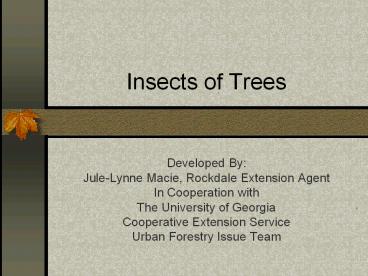Insects of Trees - PowerPoint PPT Presentation
1 / 39
Title:
Insects of Trees
Description:
Insects of Trees Developed By: Jule-Lynne Macie, Rockdale Extension Agent In Cooperation with The University of Georgia Cooperative Extension Service – PowerPoint PPT presentation
Number of Views:104
Avg rating:3.0/5.0
Title: Insects of Trees
1
Insects of Trees
- Developed By
- Jule-Lynne Macie, Rockdale Extension Agent
- In Cooperation with
- The University of Georgia
- Cooperative Extension Service
- Urban Forestry Issue Team
2
Insects are often blamed for others damage
- Sapsuckers
- Herbicide damage
- Lightning
- Too much or not enough water
- Squirrels, roof rats
- String trimmer
- Beaver
- Deer
- Secondary pests
- Ants
- Bees
- Long horned beetles
- Termites
3
When looking at damage
- Think mouthparts
- Holes chewing
- Wilting, yellowing piercing sucking
- Speckling rasping sucking
4
The Real Boring Insects
- Chewing mouthparts, so think holes
5
Bark Beetles
- 3 different beetles southern pine beetle, Ips
engraver, Black turpentine - Needles turn yellow from tips back
- Larvae feed under bark
6
Southern Pine vs. Black Turpentine Beetles
- Size compared to a grain of rice
7
Under the Bark
- Beetles attack stressed native pine trees
- Second generation beetles attack surrounding
trees - Blue stain fungus
- Galleries
8
Pitch Tubes
- A sign of attack.
- Beetles are sometimes stuck in pitch
9
Control for Homeowners
- Sanitation!
- Homeowners do not have equipment to spray
preventatively
10
Asian Ambrosia Beetles
- Attack smooth bark trees in early spring when
leaves expanding - Bore deep into heartwood
- Need moist wood
- Toothpicks
- No good chemical control
- Cut down
11
Asian Long Horned Beetle
- Pest from China
- Attacks maples, birch, willow, poplars and
horsechestnut. - Be on the lookout for this pest.
12
Various Wood Boring Beetles
- Attack various trees
- Female lays eggs on trunk and larva bore under
bark
13
Dogwood Borers
- Clear winged moth
- Attacks older dogwoods under stress
- Larvae bore under bark
14
Caterpillars
- Chewing mouthparts so think holes
15
Nantucket Pine Tip Moth
- Small orange moth
- attacks young pines
- causes stunting and deformity. Trees will
grow out of it
16
Bagworms
- Deciduous and evergreens
- Insecticides only if early in season
- Fall move to ends of branch and pupate
- Males fly to females
- Lay eggs in bag
- Prune and discard!
17
Tent Caterpillars
- Spring pest
- Tents in interior of tree
- Prefer fruit trees
- Pretty caterpillars
- Capable of total defoliation
- Will not kill a tree (usually)
18
Orange Striped Oakworm
19
Fall Webworms
- The large flimsy nests of the fall webworm are a
familiar sight along road sides in later summer.
The nests grow larger and larger until entire
branches are covered
20
Gypsy Moth
- Late instar gypsy moth caterpillar on leaf (note
body hairs and rows of red and blue dot pairs on
back) - Be on the lookout for this pest
21
Sawflies
- Feed in groups
- A type of wasp
- Defense mechanism
22
Beetles
- Both adult and larvae can cause damage
23
Elm Leaf Beetles
24
Japanese Beetles
25
Twig Girdler
26
Sucking Insects
- Needle-like mouth so think yellowing, wilting and
deformity
27
Bark Aphids
28
Wooly Alder Aphids
- Piercing sucking
- Suck plant sap
- Honeydew
- Sooty mold
- 30 generations a year
- Live birth
- Wings at times
29
Aphids in general
- Clients will often say their problem is ants on
their plants
30
Scales Soft, Armored, Pit, Oystershell, etc.
- Piercing sucking
- Crawlers
- Waxy covering
- Systemic insecticides
- Sooty mold
31
Other Insects
- Miscellaneous damage, but is it really necessary
to control?
32
Galls
33
Dogwood Club Gall Midge
- Causes spindle-shaped swellings
- Spray in early spring
- Prune later in season
34
Leaf Miners
35
Cicadas
36
European Hornets
37
Sycamore Lacebug
38
Acknowledgements
- www.forestryimages.org
- Florida Division of Forestry
- http//eny3541.ifas.ufl.edu/
- University of Kentucky Entomology
- www.bugwood.org
39
Acknowledgements
- Funds for this project were provided by the Urban
and Community Forestry Financial Assistance
Program administered by the Georgia Forestry
Commission. - The U. S. Department of Agriculture (USDA)
prohibits discrimination in all its programs and
activities on the basis of race, color, national
origin, gender, religion, age, disability,
political beliefs, sexual orientation, and
marital or family status. (Not all prohibited
bases apply to all programs.) Persons with
disabilities who require alternative means for
communication of program information (Braille,
large print, audiotape, etc.) should contact
USDAs TARGET Center at 202-720-2600 (voice and
TDD). - To file a complaint of discrimination, write
USDA, Director, Office of Civil Rights, Room
326-A, Whitten Building, 14th and Independence
Avenue, SW, Washington, DC 20250-9410 or call
202-720-5964 (voice or TDD). USDA is an equal
opportunity provider and employer.































